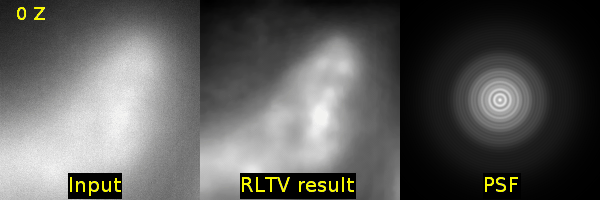Richardson-Lucy Total Variation Deconvolution
In this example we will use SciJava Ops to perform Richardson-Lucy (RL) deconvolution on a 3D dataset (X, Y, Z) of a HeLa cell nucleus stained with DAPI (4′,6-diamidino-2-phenylindole) and imaged on an epifluorescent microscope at 100x. The SciJava Ops framework currently supports the standard RL algorithm as well as the Richardson-Lucy Total Variation (RLTV) algorithm, which utilizes a regularization factor to limit the noise amplified by the RL algorithm 1. Typically, the RLTV algorithm returns improved axial and lateral resolution when compared to RL.
You can download the 3D HeLa cell nuclus dataset here.

Results of RLTV deconvolution on the sample data.
RLTV parameter descriptions
The table below contains the necessary parameter values needed for the kernelDiffraction Op to create the synthetic
point spread function (PSF) using the Gibson-Lanni model 2 for the sample HeLa cell nucleus dataset.
Parameter |
Value |
|---|---|
Iterations |
15 |
Numerical aperature |
1.45 |
Emission wavelength (nm) |
457 |
Refractive index (Immersion) |
1.5 |
Refractive index (Sample) |
1.4 |
Lateral resolution (μm/pixel) |
0.065 |
Axial resolution (μm/pixel) |
0.1 |
Particle/sample position (μm/pixel) |
0.0 |
Regularization factor |
0.002 |
SciJava Ops via Fiji’s scripting engine with script parameters:
#@ OpEnvironment ops
#@ ImgPlus img
#@ Integer iterations(label="Iterations", value=30)
#@ Float numericalAperture(label="Numerical Aperture", style="format:0.00", min=0.00, value=1.45)
#@ Integer wavelength(label="Emission Wavelength (nm)", value=550)
#@ Float riImmersion(label="Refractive Index (immersion)", style="format:0.00", min=0.00, value=1.5)
#@ Float riSample(label="Refractive Index (sample)", style="format:0.00", min=0.00, value=1.4)
#@ Float lateral_res(label="Lateral resolution (μm/pixel)", style="format:0.0000", min=0.0000, value=0.065)
#@ Float axial_res(label="Axial resolution (μm/pixel)", style="format:0.0000", min=0.0000, value=0.1)
#@ Float pZ(label="Particle/sample Position (μm)", style="format:0.0000", min=0.0000, value=0)
#@ Float regularizationFactor(label="Regularization factor", style="format:0.00000", min=0.00000, value=0.002)
#@output ImgPlus psf
#@output ImgPlus result
import net.imglib2.FinalDimensions
import net.imglib2.type.numeric.real.FloatType
import net.imglib2.type.numeric.complex.ComplexFloatType
// convert input image to float
img_float = ops.op("create.img").input(img, new FloatType()).apply()
ops.op("convert.float32").input(img).output(img_float).compute()
// use image dimensions for PSF size
psf_size = new FinalDimensions(img.dimensionsAsLongArray())
// convert the input parameters to meters (m)
wavelength = wavelength.toFloat() * 1E-9
lateral_res = lateral_res * 1E-6
axial_res = axial_res * 1E-6
pZ = pZ * 1E-6
// create the synthetic PSF
psf = ops.op("create.kernelDiffraction").input(psf_size,
numericalAperture,
wavelength,
riSample,
riImmersion,
lateral_res,
axial_res,
pZ,
new FloatType()).apply()
// deconvolve image
result = ops.op("deconvolve.richardsonLucyTV").input(img_float, psf, new FloatType(), new ComplexFloatType(), iterations, false, false, regularizationFactor).apply()
#@ OpEnvironment ops
#@ ImgPlus img
#@ Integer iterations(label="Iterations", value=30)
#@ Float numericalAperture(label="Numerical Aperture", style="format:0.00", min=0.00, value=1.45)
#@ Integer wavelength(label="Emission Wavelength (nm)", value=550)
#@ Float riImmersion(label="Refractive Index (immersion)", style="format:0.00", min=0.00, value=1.5)
#@ Float riSample(label="Refractive Index (sample)", style="format:0.00", min=0.00, value=1.4)
#@ Float lateral_res(label="Lateral resolution (μm/pixel)", style="format:0.0000", min=0.0000, value=0.065)
#@ Float axial_res(label="Axial resolution (μm/pixel)", style="format:0.0000", min=0.0000, value=0.1)
#@ Float pZ(label="Particle/sample Position (μm)", style="format:0.0000", min=0.0000, value=0)
#@ Float regularizationFactor(label="Regularization factor", style="format:0.00000", min=0.00000, value=0.002)
#@output ImgPlus psf
#@output ImgPlus result
from net.imglib2 import FinalDimensions
from net.imglib2.type.numeric.real import FloatType
from net.imglib2.type.numeric.complex import ComplexFloatType
# convert input image to float
img_float = ops.op("create.img").input(img, FloatType()).apply()
ops.op("convert.float32").input(img).output(img_float).compute()
# use image dimensions for PSF size
psf_size = FinalDimensions(img.dimensionsAsLongArray())
# convert the input parameters to meters (m)
wavelength = float(wavelength) * 1E-9
lateral_res = lateral_res * 1E-6
axial_res = axial_res * 1E-6
pZ = pZ * 1E-6
# create the synthetic PSF
psf = ops.op("create.kernelDiffraction").input(psf_size,
numericalAperture,
wavelength,
riSample,
riImmersion,
lateral_res,
axial_res,
pZ,
FloatType()).apply()
# deconvolve image
result = ops.op("deconvolve.richardsonLucyTV").input(img_float, psf, FloatType(), ComplexFloatType(), iterations, False, False, regularizationFactor).apply()